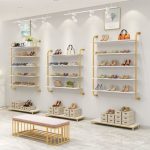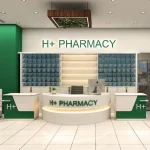Window displays are crucial for attracting customers and conveying a brand’s identity. Various types of window displays cater to different retail strategies, target markets, and product types. Here are the main types.
Open Window Displays
Open window displays are characterized by their lack of walls or screens behind the merchandise, allowing passers-by to see directly into the store. This design creates a seamless connection between the interior ambiance and the exterior, generating excitement and intrigue among potential customers.
Key Features:
- Visibility: Shoppers can view not only the window display but also the activities and products inside the store, enhancing the overall shopping experience.
- In-store Experience: This type of display is particularly effective for retailers that focus on creating engaging in-store experiences, as it invites customers to explore further.
- Visual Merchandising: Open displays often incorporate mannequins or product arrangements that align with the store’s visual merchandising strategies, showcasing items in a way that highlights their appeal.
Advantages:
- Attracts Attention: The openness of these displays can capture the interest of passers-by, making them more likely to enter the store.
- Encourages Exploration: By allowing glimpses of the store’s interior, open displays can entice customers to discover more about what’s offered inside.
- Dynamic Interaction: The flow of activity between the store and street can create a lively atmosphere, drawing in more foot traffic.
Challenges:
- Maintenance: One significant drawback is that any visible fixings or wiring cannot be concealed, which requires careful management to maintain a tidy appearance. Untidy displays can detract from the overall effectiveness and aesthetic appeal.
- Limited Control Over Environment: External factors such as weather or street activity can impact how well an open display performs, as it relies heavily on external visibility and engagement.
Closed Window Displays
Closed window displays are characterized by solid walls or screens that completely enclose the display area, separating it from the rest of the store. This design allows retailers to create focused and immersive presentations of their products, drawing attention directly to the items on display without distractions from the store’s interior.
Key Features:
- Enclosure: The solid backdrop can be a permanent architectural feature or a temporary installation, providing a clean and defined space for showcasing merchandise.
- Visual Control: Closed displays enable retailers to control the visual narrative, allowing for detailed scenes and thematic presentations that enhance brand storytelling.
- Space Utilization: They often incorporate shelves or wall-mounted signage, maximizing the use of vertical space for additional product visibility.
Advantages:
- Product Protection: Merchandise is shielded from potential disruption by passers-by, reducing the risk of damage or disarray during busy shopping hours.
- Focused Attention: The separation from the store interior ensures that all customer focus is directed towards the displayed products, making it easier to highlight specific items or promotions.
- Enhanced Atmosphere: Retailers can create a unique ambiance within the display, setting seasonal themes or moods that may differ from the store’s overall lighting and decor.
- Creative Freedom: The enclosed space allows for more elaborate designs and props, enabling visual merchandisers to craft intricate scenes that engage customers’ imaginations.
Challenges:
- Construction Complexity: Closed window displays can be more complex and costly to construct compared to open displays due to their structural requirements.
- Floor Space Consumption: They occupy valuable retail floor space that could otherwise be used for selling products directly.
- Time Investment: Creating visually appealing closed displays often requires more time and effort, as every element must contribute cohesively to the overall presentation.
Semi-Closed Window Displays
Semi-closed window displays are a hybrid design that combines elements of both open and closed displays. They allow for partial visibility into the store while still providing a structured backdrop for showcasing products. This type of display typically features a partition wall that rises to a certain height, effectively concealing some aspects of the store while inviting curiosity about the products on display.
Key Features:
- Partial Visibility: These displays enable passers-by to glimpse some elements of the store, creating a sense of intrigue without fully revealing the interior.
- Flexible Design: Retailers can utilize various materials for the partition, including free-standing frames and graphics, allowing for customization based on brand identity and seasonal themes.
- Product Focus: By limiting visibility, semi-closed displays draw attention directly to specific products or collections, making them ideal for highlighting new arrivals or special promotions.
Advantages:
- Balanced Engagement: They strike a balance between inviting customers in and creating a focused display area, making them effective for engaging potential shoppers.
- Enhanced Curiosity: The partial concealment encourages curiosity, prompting customers to enter the store to discover more about what is being offered.
- Visual Appeal: The combination of openness and structure allows for creative visual merchandising strategies that can enhance the overall aesthetic of the storefront.
- Cost-Effective: Semi-closed displays can be more affordable than fully enclosed designs while still providing significant visual impact.
Challenges:
- Design Complexity: Striking the right balance between openness and concealment requires careful planning to ensure that the display remains cohesive and visually appealing.
- Potential Distractions: If not designed thoughtfully, visible elements from inside the store may distract from the products showcased in the window.
Island Window Displays
Island window displays are unique merchandising setups typically found in larger retail environments, such as department stores or flagship locations. These displays consist of freestanding structures—often podiums, plinths, or shelving—that are strategically placed within open spaces, allowing customers to view products from all sides.
Key Features:
- 360-Degree Visibility: Island displays can be appreciated from multiple angles, which enhances customer engagement and allows for a comprehensive view of the showcased products.
- Floating Design: These displays “float” in the middle of the retail space, creating a sense of depth and drawing attention to specific product ranges or promotions.
- Flexible Configuration: Retailers can customize island displays with various shelving heights and arrangements to highlight different items effectively.
Advantages:
- Enhanced Interaction: The accessibility from all sides encourages shoppers to walk around and interact with the display, increasing the likelihood of purchase.
- Space Utilization: Island displays effectively fill large open areas without overwhelming the space, making them ideal for expansive storefronts.
- Showcase Variety: They allow retailers to present a diverse range of products simultaneously, making it easier to promote new arrivals or seasonal collections.
- Visual Impact: The three-dimensional nature of island displays can create striking visual focal points that capture attention and draw customers into the store.
Challenges:
- Lighting Considerations: Since these displays are visible from all directions, lighting must be carefully planned to avoid glare or shadows that could obscure products.
- Space Requirements: Island displays require ample floor space, which may not be feasible for smaller retail environments.
Corner Window Displays
Corner window displays are strategically positioned at the intersection of two exterior walls, creating a visually appealing and functional merchandising space. These displays maximize visibility by allowing shoppers to view products from multiple angles, making them an effective tool for attracting customers approaching from different directions.
Key Features:
- Dual Visibility: By utilizing the corner space, these displays can showcase products effectively from two distinct street views, enhancing their impact on foot traffic.
- Box-like Structure: The design often resembles a large box, which can be configured as open, closed, or semi-closed, depending on the retailer’s visual merchandising strategy.
- Engaging Design: The unique positioning encourages creative layouts that can incorporate various elements such as mannequins, props, and signage to enhance the overall presentation.
Advantages:
- Increased Foot Traffic: The prominent location of corner displays captures the attention of passers-by from multiple angles, increasing the likelihood of customer engagement and store entry.
- Showcasing Variety: Retailers can display a wider range of products simultaneously, making it easier to highlight collections or themed promotions that appeal to diverse customer interests.
- Enhanced Brand Presence: Corner displays serve as focal points that can significantly enhance a store’s branding efforts by creating memorable visual experiences that resonate with shoppers.
- Flexible Design Options: Depending on the products being showcased and the desired aesthetic, corner displays can be customized in various ways to align with seasonal themes or promotional events.
Challenges:
- Design Complexity: Creating an attractive and cohesive display that looks good from all angles can be challenging. Careful planning is essential to ensure that the arrangement is visually appealing from both sides.
- Space Constraints: While corner displays can be effective in larger retail environments, they may require careful consideration in smaller spaces to avoid overcrowding.
Shadow Box Window Displays
Shadow box window displays are compact, enclosed display cases designed to showcase smaller items in an intimate setting. They are particularly effective for highlighting delicate products such as jewelry, cosmetics, or collectibles.
Key Features:
- Box-like Structure: Typically recessed into the storefront, these displays create a contained space that draws attention to the items inside.
- Focused Presentation: The design allows for detailed arrangements that can highlight the craftsmanship and features of the products.
- Intimate Viewing: Shadow boxes are usually viewed by one person at a time, fostering a personal connection with the displayed items.
Advantages:
- Enhanced Visibility: These displays allow retailers to showcase intricate details that might be overlooked in larger displays, making them ideal for high-value or intricate items.
- Controlled Environment: The enclosed nature protects items from dust and damage while allowing for creative lighting and background designs.
- Thematic Storytelling: Retailers can create themed displays that resonate with customers, enhancing brand storytelling through visual merchandising.
- Space Efficiency: Shadow boxes are suitable for smaller storefronts, maximizing display potential without requiring extensive floor space.
Challenges:
- Limited Space: The compact nature may restrict the number of items displayed, requiring careful selection and arrangement to ensure visual impact.
- Accessibility: Since they are often viewed from a distance, ensuring that lighting and visibility are optimal is crucial to prevent glare or shadows that could obscure details.
Elevated Window Displays
Elevated window displays are a distinctive type of visual merchandising that involves positioning products above ground level, typically on podiums, plinths, or shelves. This design strategy is particularly effective in attracting attention from passers-by, as it places featured items at an optimal eye level.
Key Features:
- Height Advantage: By raising products off the ground, elevated displays ensure that they are more visible to customers walking by, making them stand out in a crowded retail environment.
- Versatile Design: These displays can be designed in either open or closed styles, allowing for flexibility in presentation based on the retailer’s needs and the type of products being showcased.
- Strategic Lighting: Often enhanced with accent lighting, elevated displays can highlight specific items and create a dramatic effect that draws further attention.
Advantages:
- Increased Visibility: Elevating products makes them more noticeable, which is especially beneficial for high-value items such as jewelry or cosmetics that retailers want to promote.
- Engagement Opportunities: The height can encourage customers to stop and engage with the display, potentially leading to increased foot traffic and sales.
- Focus on Featured Products: Elevated displays allow retailers to spotlight new arrivals or seasonal items effectively, making it easier for customers to identify key products.
- Creative Presentation: Retailers can utilize various heights and arrangements to create visually interesting displays that capture customer interest and convey brand identity.
Challenges:
- Accessibility: While elevated displays are visually appealing, they may make it difficult for some customers to interact with the products directly, especially if items are placed too high.
- Design Complexity: Creating an effective elevated display requires careful planning to ensure that the arrangement is both aesthetically pleasing and functional.
Conclusion
Each type of window display serves unique purposes and can significantly influence customer engagement. Retailers should choose based on their specific goals, target audience, and available space.
More Posts:
10 Retail Store Fixture Suppliers in USA
10 Top Acrylic Display Suppliers in the UK





